|
Plumbing 101
I have read many DIY plans over the years
and have also written a few myself. One of the things I have
noticed is many articles make the assumption that you know
all of the terms and methods needed to build the project.
I have answered many of these types of questions in the DIY
forum here at Reef Central in a piecemeal form. Hopefully
by putting this information in one place for easy reference,
it will help you with all of your future DIY projects.
In the coming months, this column will
cover more general construction methods, as well as specific
DIY projects. I hope that this column will allow you to build
things that you would not have attempted to in the past, as
well as improve your results. DIY projects don't always save
you money, but they are always a learning experience and a
lot of fun. You will also have a sense of pride knowing you
built it yourself.

Plumbing
Terms
Here
is a list of cryptic plumbing acronyms that you will run into
from time to time and what they mean. Now, when you go into
the plumbing store you will be able to talk like a real plumber.
| OD |
Outside Diameter. |
| ID |
Inside Diameter |
| NPT |
National Pipe Taper pipe
threads are tapered unlike normal bolts and nuts, which
are straight. Most pipe threads you will run into will
be tapered. |
| NPS |
National Pipe Straight |
| FNPT |
Female National Pipe Taper,
a fitting with internal threads. |
| MNPT |
Male National Pipe Taper,
a fitting with external threads. |
| TPI |
Number of threads per
inch. |
| GHT |
Garden
Hose Thread. GHT is not NPS. It is it's own diameter and
TPI. |
| Slip |
A PVC fitting without
any threads that is intended to be glued. |
| Street |
A fitting that on one
side has the same OD as a piece of pipe that size. This
allows it to slip or screw if it has threads into another
fitting like a piece of pipe. Sometimes called a Spigot
fitting. |
| Reamer |
A pipe reamer is tapered
like a NPT tap so the tapered tap has a tapered hole to
thread. The taper rate is 3/4" per foot. |
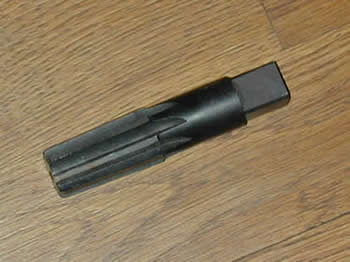 |
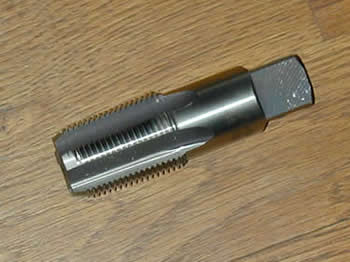 |
|
NPT Reamer
|
NPT tap
|
Pipe Tap
to Drill Size Table
If
you need to drill a hole for a threaded fitting in your project
this table will tell you what size drill bit you will need
to use. There are several ways to drill holes in PVC and acrylic.
One way is to buy drill bits that were designed to drill plastic.
They are available in a few sizes. US
Plastic Corp. carries them. The next way is to make your
own by using Bob's instructions at my
Website on how to grind a normal speed bit so it will
drill plastic. UniBits work very well also, the best price
I have found for them is at Enco.
A normal hole saw also works if you can find one the right
size.
|
Pipe Tap Size -
TPI
|
Drill
Bit Without Reamer
|
Drill
Bit With Reamer
|
| 1/16" - 27 |
| 1/8" - 27 |
|
1/4" - 18
|
|
3/8" - 18
|
|
1/2" - 14
|
|
3/4" - 14
|
|
1" - 11 1/2
|
|
1 1/4" -
11 1/2
|
|
1 1/2" -
11 1/2
|
|
1 3/4" -
11 1/2
|
|
2" - 11 1/2
|
|
2 1/2" -
8
|
|
3" - 8
|
|
3 1/2"
|
|
4"
|
|
5"
|
|
6"
|
|
|
C (.242)
|
|
Q
(.332)
|
|
7/16"
|
|
9/16"
|
|
45/64"
|
|
29/32"
|
|
1 9/64"
|
|
1 31/64"
|
|
1 23/32"
|
|
|
|
2 3/16"
|
|
2
39/64"
|
|
3
15/64"
|
|
|
|
|
|
|
|
|
|
|
A (.234)
|
|
21/64"
|
|
27/64"
|
|
9/16"
|
|
11/16"
|
|
57/64"
|
|
1 1/8"
|
|
1 15/32"
|
|
1 45/64"
|
|
1 15/16"
|
|
2 11/64"
|
|
2
25/32"
|
|
3
9/32"
|
|
3
3/4"
|
|
4
1/4"
|
|
5
1/4"
|
|
6
1/4"
|
|
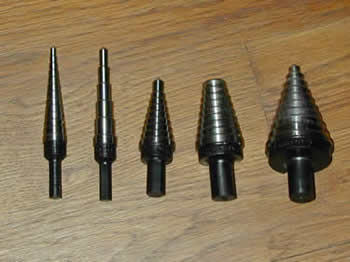 |
|
Unibits
|
PVC Pipe Sizes
PVC
pipes are sized by their ID (inside diameter) but sometimes,
in DIY projects, we also need to know their OD (outside diameter).
Having this information will help us size other things to
PVC fittings like Acrylic tubing.
|
|
|
Size
|
ID
|
OD
|
ID
|
OD
|
| |
|
|
|
|
| 1/2" |
1/2" |
0.840" |
0.526" |
0.840" |
| 3/4" |
3/4" |
1.050" |
0.722" |
1.050" |
| 1" |
1" |
1.315" |
0.935" |
1.315" |
| 1 1/4" |
1 1/4" |
1.660" |
1.256" |
1.660" |
| 1 1/2" |
1 1/2" |
1.900" |
1.476" |
1.900" |
| 2" |
2" |
2.375" |
1.913" |
2.375" |
| 2 1/2" |
2 1/2" |
2.875" |
2.291" |
2.875" |
| 3" |
3" |
3.500" |
2.864" |
3.500" |
| 4" |
4" |
4.500" |
3.786" |
4.500" |
| 5" |
5" |
5.563" |
|
|
| 6" |
6" |
6.625" |
5.709" |
6.625" |
| 8" |
8" |
8.635" |
7.565" |
8.625" |
| 10" |
10" |
10.75" |
|
|
| 12" |
12" |
12.75" |
|
|
|

Solvent Cement Joining of Plastic
Pipe FAQ
Here are some answers to questions
about solvent cementing pipes. The better we understand these
processes, the better job we will be able to do to make leak
proof joints.
How does solvent cement work?
The solvents penetrate the plastic surface and cause the plastic
to swell. The swelling continues until the gaps between the
pipe and the fitting walls are closed and pressing against
each other.
What plastics can be solvent cemented?
PVC (Polyvinyl chloride) , CPVC (chlorinated polyvinyl), ABS
(Acetylonitrile-Butadiene-Styrene), polycarbonate [PC or Lexan]
Styrene, Geloy and other plastic materials.
What plastics can not be solvent cemented?
Polyethylene, polypropylene, polybutylene, nylon and other
engineering plastics (usually polyolefins).
What about using solvent cement when
a joint is wet?
All solvent cements have the ability to absorb some water
and still perform well enough to effect an adequate joint.
However, research shows that the presence of 10% water in
solvent cement can slow penetration and swelling by 65%. This
joint with water inside will always be an inferior joint and
subject to problems.
What is the difference between pipe
cleaner and pipe primer?
A pipe cleaner is a mixture of solvents used to clean any
dirt or foreign materials on the surface of the pipe which
could prevent the penetration of the cement into the pipe
surface. The cleaner must be wiped off with a clean rag immediately.
A primer is a mixture of solvents used to penetrate the pipe
and fitting and start the swelling process ahead of the application
of the solvent cement. It is not wiped off. The solvent cement
is applied on top of the primer immediately while wet.
What is the difference between set and
cure time?
Set time is that initial period of swelling required to give
the joint enough strength to be gently handled. Cure time
is the total time period of required swelling for the joint
to acquire enough strength that it can perform it's job transporting
materials through it (at whatever pressure and temperature
required) without coming apart or leaking.
What makes a good solvent cement joint?
A) User selects the proper cement and follows proper procedures
B) Cut pipe square
C) De-burr pipe inside and out
D) Check the dry fit
E) Use pipe cleaner when necessary
F) Use pipe primer on every joint
G) Apply cement properly
H) Insert pipe into the fitting properly
I) Wait for the proper set and cure times

Solvent Cementing Instructions
This is the 5 step process for making a
good solvent cement pipe joint. We often have questions about
how long a joint needs to set before we can use it. This explains
that temperature, humidity and pipe size all effect setup
and cure time. Using a joint before it is fully cured, will
allow moisture into the joint which will weaken it which may
lead to future failure.
1. Condition the pipe and fittings so that
they are at the same ambient temperature. Cut the end of the
pipe square by using a fine-toothed hand saw and miter box
or power saw. Tube cutters with wheels designed for use with
PVC are acceptable, provided they do not leave a raised bead
on the outside diameter of the pipe. There are shears available
for cutting small diameter PVC pipe also.
Note - Cutting PVC Pipe
You can cut PVC pipe with almost anything. They make handsaws
especially for cutting PVC. You can use a circular saw with
a plastic cutting or plywood blade. They also make shears
for cutting PVC up to 1" and they work very well. The
important thing is to have a straight and square cut on the
end of the pipe so it seats all the way to the bottom of the
fitting all of the way around.
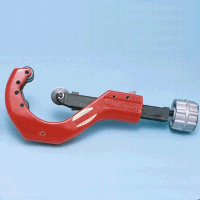 |
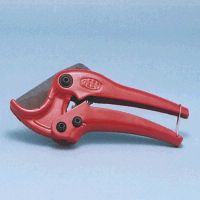 |
|
PVC Pipe Cutter
|
PVC Shears
|
2. Using a chamfering tool or file put
a 10 to 15 degree chamfer (bevel) on the end of the pipe.
Note - Beveling PVC Pipe
Before you glue a fitting on a piece of PVC pipe you should
bevel the PVC pipe. There are tools that do this. The ones
for small PVC pipe (Figures 1 & 2) are very inexpensive
but the ones for large PVC pipe (Figure 3) are over
$100. These tools will round the inside edge of the pipe and
will bevel the outside edge to 15 degrees. You can get the
ones for small pipes at Home Depot, Lowes... and the large
one from plumbing supply companies.
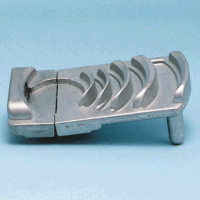 |
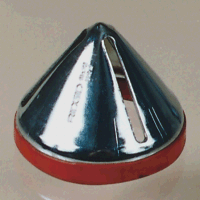 |
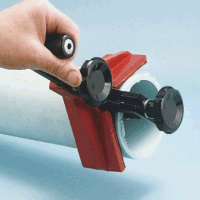 |
|
PVC Pipe Bevel -
Figure 1
|
PVC Pipe Bevel -
Figure 2
|
PVC Pipe Bevel -
Figure 3
|
3. Check the dry fit of the pipe and fitting.
Pipe should enter the fitting about 1/3 to 3/4 depth. Position
the pipe and fitting to assure alignment. Using a clean rag,
wipe the pipe surface and fitting socket to remove all dirt,
moisture, and grease. If wiping fails to clean the surface,
a chemical cleaner must be used.
4. Using a clean natural bristle brush
about 1/2 the size of the pipe diameter, freely apply the
primer to the fitting socket with a scrubbing motion until
the surface is penetrated. Repeated applications may be necessary.
Now apply the primer to the pipe surface equal to the depth
of the fitting socket in the same manner, making sure the
surface is well penetrated. Again apply primer to the socket,
to make sure it is still damp.
5. Using a clean natural bristle brush
(not a dauber brush) 1/2 the size of the pipe diameter, flow
on a heavy coat of solvent cement to the male end of the pipe.
Load the brush and do not trim. The amount should be more
than sufficient to fill any gap. Next apply a liberal coat
of solvent cement to the inside of the socket, using straight
outward strokes to keep excess cement out of the socket. While
BOTH SURFACES are STILL WET with solvent cement, insert the
pipe into the socket with a 1/4 turn twisting motion. A pair
of strap wrenches (shown below) or a vice and strap wrench
will help with the 1/4 turn on pipes larger than you can turn
by hand. The pipe MUST go to the BOTTOM of the socket. The
application of solvent cement to pipe and fitting, and the
insertion of the pipe into the fitting, should be completed
in LESS THAN ONE MINUTE. If necessary, use two people to simultaneously
apply the solvent to pipe and fitting. Hold the joint together
for approximately 30 seconds until both surfaces are firmly
gripped. Allow proper set time before disturbing joints. After
assembly, a properly made joint will usually show a bead of
cement around its entire perimeter, this should be brushed
off. Allow the joint to cure for an adequate time before pressure
testing.
Initial
Joint Set Times
|
Temperature Range
During Assembly
|
Pipe Sizes
|
Pipe Sizes
|
Pipe Sizes
|
| |
1/2" to 1 14/" |
1 12/" to 3" |
4" to 8" |
|
60 to 100 degrees
Fahrenheit
|
15 Minutes |
30 Minutes |
1 Hour |
|
40 to 60 degrees
Fahrenheit
|
1 Hour |
2 Hours |
4 Hours |
Joint Cure
Times at a Relative Humidity of 60% or less
| Temperature Range During Assembly |
Pipe Sizes |
Pipe Sizes |
Pipe Sizes |
| |
1/2" to 1 14/" |
1 12/" to 3" |
4" to 8" |
|
60 to 100 degrees
Fahrenheit
|
1 Hour |
2 Hours |
6 Hours |
|
40 to 60 degrees
Fahrenheit
|
2 Hours |
4 Hours |
12 Hours |

Working
with Bulkhead Fittings
The main thing to remember about working with bulkhead fittings
is to have the fitting you are going to use in your hand before
you drill the hole for it. The reason for this is because
there are a number of bulkhead fittings with the same ID that
have a broad range of OD, which will require a different size
hole. The brand and strength of the fitting will effect its
OD. The gasket will always go on the head end of the bulkhead
fitting never the nut end regardless which end of the fitting
is in the water. A sealed fitting is a sealed fitting. Bulkhead
strainers are nice for keeping creatures in your system from
getting sucked down the drain and clogging it up.
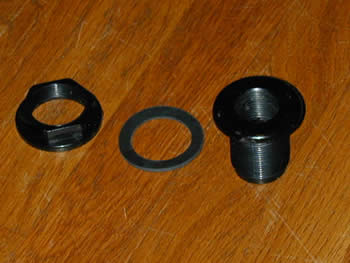 |
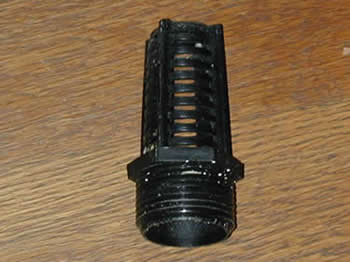 |
|
Bulkhead Fitting
|
Bulkhead Strainer
|
Ball and
Gate Valves
Ball valves and gate valves come in slip joint and FNPT with
a union on one end or both. This makes it easy for you to
be able to get exactly what you need for your project. Ball
valves are best used for on/off applications. A gate valve
works best if you need to adjust the flow between on and off.
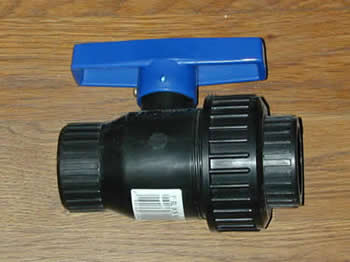 |
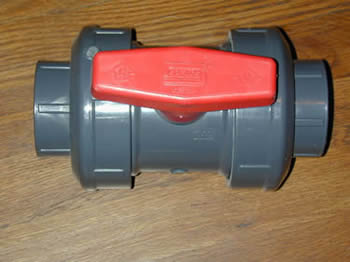 |
|
Single Union Ball
Valve
|
Dual Union Ball
Valve
|
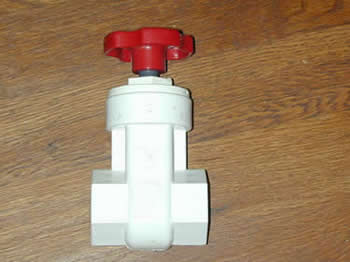 |
|
Gate
Valve
|
Unions
A union allows you to have a connection in a pipe that can
be opened up for service and then closed back up for a water
tight seal. For a DIY project they also make a nice o-ring
flange ready to glue onto your PVC or acrylic pipe."
Compression Fitting
A compression fitting allows you to adjust the length or rotation
of two pieces of pipe.
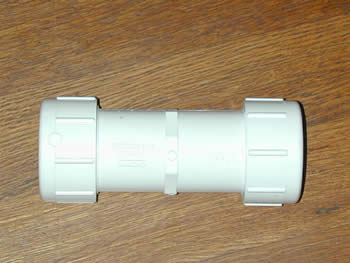 |
|
Compression Coupling
|
Flexible PVC
Flexible PVC has the same ID and OD as rigid PVC pipe and
you can glue regular PVC schedule 40 fittings on it. Use WELD-ON
725 Wet 'R Dry to glue it. Flexible PVC makes a very nice
looking job and is very easy to work with.
No tap, through wall fitting
If you need to put a fitting through the wall of a PVC pipe
you can make your own bulkhead fitting really cheaply. Get
a PVC male adapter and female adapter. Drill a hole in the
pipe where you want your fitting to go the size of the OD
of the threaded part of the male adapter. Put some Teflon
tape on the male adapter threads and put it through the hole
in the pipe and screw the female adapter onto it until they
both pull up against the inner and outer wall of the pipe.
Now run a bead of Marine Goop around the fitting where it
meets the pipe to seal the joint. You now have a fitting through
the wall of your pipe for less than $1.
Small Tubing Fittings
Small tubing used on RO/DI systems and things like calcium
reactors use two major brands of fittings, Jaco and John Guest
Super Speedfit. The Jaco fittings crimp the tube in the fitting
and the John Guest fittings are push in fittings. All you
have to do to remove the tube from a John Guest fitting is
depress a little ring around the tube and pull the tube out.
There is a wide variety if each type of fitting. US Plastic
carries most of them along with the colored tubing used with
them. They come in 5/16" through 1/2".

Where to find things
If you don't have a well-stocked plumbing supply near where
you live, there are several good ones on the Internet.
www.PlumbingSupply.com
They have almost anything and very good prices. They have
1/8" and 1/4" FNPT by 1/2" and 3/4" slip
bushings which can be very useful in your project.
Savko
Plastic Pipe & Fittings, Inc.
They also have a very nice selection of plumbing parts.
If you don't see what you want, it is worth an email or a
call because they have many things that are not on their web
site.
Aquatic
Eco-Systems Inc.
They have PVC shears, NPT taps and drill bits. They also carry
a wide selection of bulkhead fittings and flexible PVC by
the foot or the coil and the glue for it also.
United
States Plastic Corp.
They have a nice selection of small threaded fittings and
tools.
ALSCO
Industrial Products, Inc.
They have a nice selection of tools for good prices and bulk
PVC fittings.
For more information on plumbing and DIY
information visit my homepage at Snailman's
Reef.
I also invite you to read and share other DIY ideas at the
DIY
forum I moderate.
|

